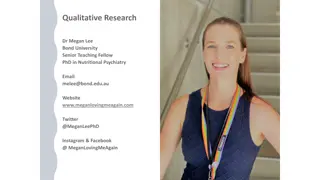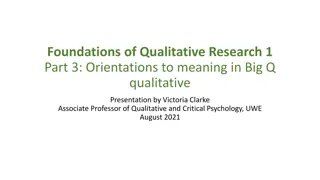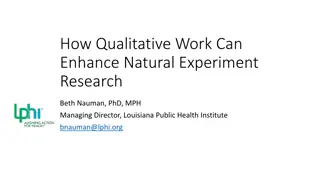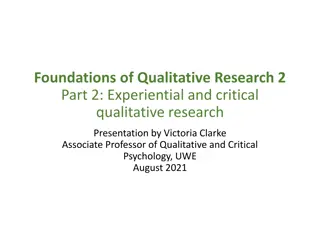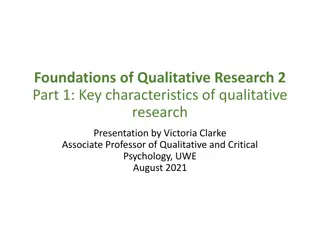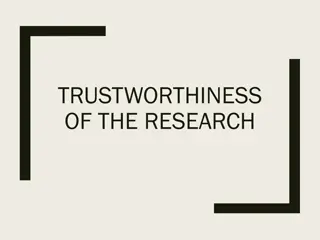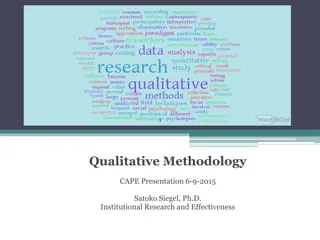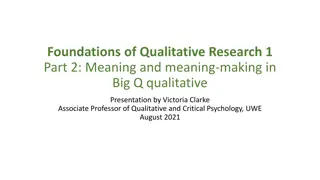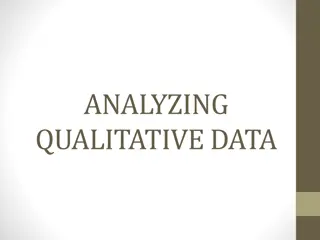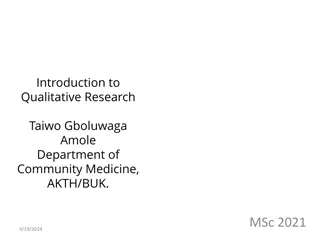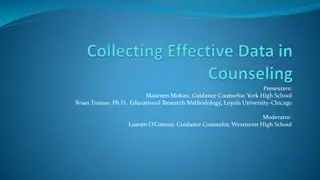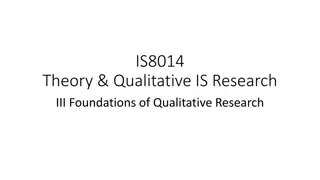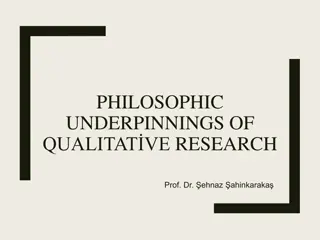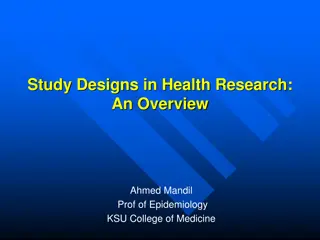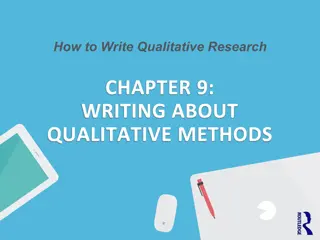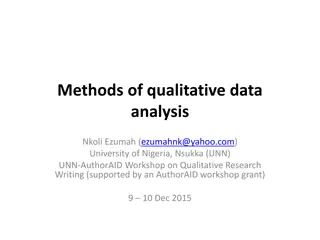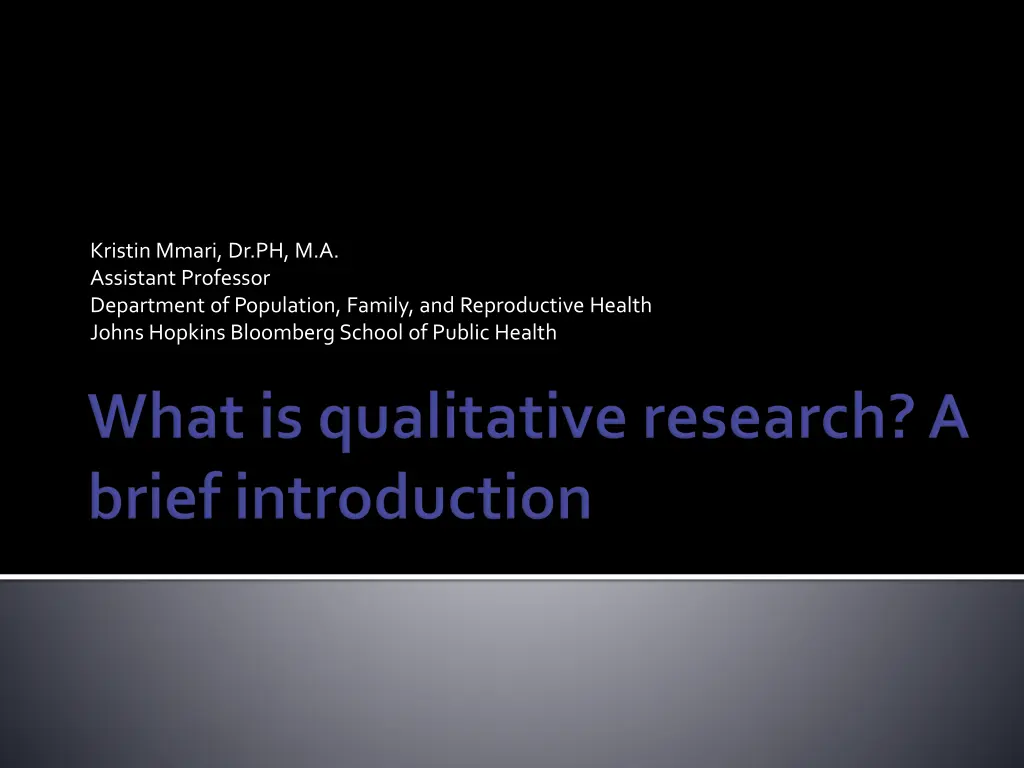
Understanding Qualitative Research and Its Impact on Health Interventions
Delve into the world of qualitative research through the lens of experts like Kristin Mmari, Dr. PH, M.A. Learn how qualitative methods are crucial in exploring complex issues, understanding participant perspectives, and shaping health interventions. Discover the importance of studying why people make certain decisions and the significance of meanings attached to behaviors like condom use, adolescent transitions, and gender roles.
Uploaded on | 1 Views
Download Presentation

Please find below an Image/Link to download the presentation.
The content on the website is provided AS IS for your information and personal use only. It may not be sold, licensed, or shared on other websites without obtaining consent from the author. If you encounter any issues during the download, it is possible that the publisher has removed the file from their server.
You are allowed to download the files provided on this website for personal or commercial use, subject to the condition that they are used lawfully. All files are the property of their respective owners.
The content on the website is provided AS IS for your information and personal use only. It may not be sold, licensed, or shared on other websites without obtaining consent from the author.
E N D
Presentation Transcript
Kristin Mmari, Dr.PH, M.A. Assistant Professor Department of Population, Family, and Reproductive Health Johns Hopkins Bloomberg School of Public Health
Qualitative research is concerned with meaning: how people interpret their experiences and how they use those interpretations to guide the way they live. (MacQueen, 2002) Qualitative methods attempt to understand the world from the perspective of the research participants. They address how and why questions, suitable for exploring new topics and obtaining insightful data on complex issues. (Teijlingen and Forrest, 2004)
When you want to know why people do the things they do: Why do some adolescents go to one clinic and not another? Why is the female condom not getting used? How can we ask women in sub-Saharan Africa about female genital mutilation? When you want to know how people make the decisions they do: How do adolescents decide when they should start dating ?
A country plagued with high rates of STI and low condom use invited a team of experts to introduce a new contraceptive option: the female condom After campaign, results showed that rates of infection had dropped; women and men were seeking STI treatment Twelve months later, treatment rates were still up, but rates of new infection were increasing
Qualitative follow-up study to explore meaning of female condom to different community groups Findings revealed: Clinicians weren t distributing condom because they thought it was laced with HIV Men didn t like the condom because it gave women a license to engage in extramarital affairs Women were conflicted; they liked the idea of independent protection, but knew that they risked abandonment by male partners
The Global Early Adolescent Study (GEAS) seeks to find both adolescent and parent meanings on: Transitions into adolescence What it is to be a boy and girl adolescent Interpersonal relationships, and how gender influences those meanings
In-depth interview (face-to-face, telephone) Focus group discussions (existing groups such as students at a school, or groups based on some characteristics) Observations (direct and participant)
Epistemology is the philosophy of knowledge how we come to know what we know Questions that need to be addressed: How reality can be known is there a real objective world out there or is it socially constructed? The relationship between the knower and what is known --does the knower have to be objective and affect the outcome as little as possible or does the knower actively co- construct knowledge? The assumptions, and principles that guide the process of knowing and the achievement of findings -- the methods used
Positivism: Framework that evolved from 19th century philosophical approach which maintained that reliable knowledge is based on direct observation or manipulation of natural phenomena through empirical, often experimental, means. the goal of science is to develop the most objective methods possible to get the closest approximation of reality. Theory is universal and not context bound Quantitative studies with highly standardized tools with precisely worded questions among representative samples
Knowledge is constructed, interpreted, and experienced by people in their interactions with each other and wider social systems (Ulin, 1992) Key components of paradigm: Researcher and participants are linked, constructing knowledge together Multiple knowledges can co-exist; impossible to have complete objectivity Understand individual in context
Positivist Interpretivist Basic assumptions Socialworld is composed of observable facts; reality is independent of the researcher Social worldis constructed of symbolic meaning observable in human acts, interactions, and language. Reality is subjective and multiple as seen from different perspectives Sources of evidence Facts are revealed through standard scientific processes and are context free Meanings are derived from perceptions, experiences, and actions in relation to social contexts Research intention Seek explanation, verification, and prediction of human behavior through causal or associative relationships Seekunderstanding, and insight into the circumstances of human behavior
Positivist approach: What is the most common method? What proportion of women in the village use oral contraceptive pills? Where do they obtain pills? Interpretivistapproach: Why do women in village use oral contraceptives? How do they make decisions about using oral contraceptives?
Lincoln & Guba (1985) proposed 4 criteria: Credible Are findings grounded in data? Dependable Are there parallels across data sources? Researchers? Confirmable Can findings be confirmed/corroborated by others? Transferable Are the conclusions transferrable to other groups/contexts?
Supposed to support a finding by showing that independent measures of it agree with it, or at least, do not contradict it What types of triangulation? Data source (people, documents, times, places) Method (observations, interviews) Researchers Data type (qualitative text, surveys, etc.)
Make an audit trail: document how the interviews were conducted, the decisions in the made field so that others will know exactly what was done Be reflexive: keep a critical account of the research process, including internal and external dialogues
What are the ways the interviews differed and how might these have affected the data? Were there any external issues that may have affected the data collected? If you find outliers can they be explained, and can they be your friends ?

